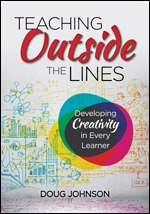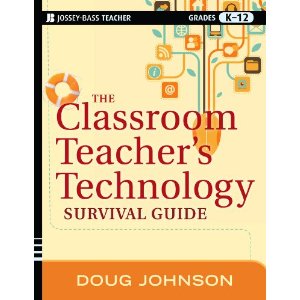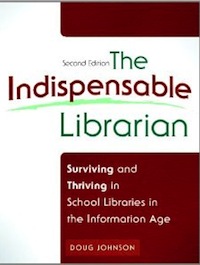E-textbook vs print textbook costs
 Thursday, January 26, 2012 at 06:21AM
Thursday, January 26, 2012 at 06:21AM A $14.95 textbook from Apple and its collaborators? That sounds like a heck of deal compared to the average $72 we are currently spending on the dead tree version. But let's play with the numbers a little and figure out an estimated cost for providing textbook access in both formats for a student from grades 7-12.
Paper text:
6 years X 6 courses X 1 textbook per course X $12 ($72/6 years use = $12 per year) = $432 per student
E-text:
6 years X 6 course X 1 textbook X $2.50 ($15/6 years use = $2.50 per year) + 1 iPad @ $500 = $590
There are some major, very likely erroneous or impossible to know, assumptions in this calculation:
- This calculation assumes that e-texts can be purchased once and then re-used each year like paper textbooks. So far, publishers have not applied the first sale doctrine to other e-books, so I wonder if this will be legal.
- This assumes that a single iPad will last six years. The oldest iPads are only two right now, so there is really no way of determining the life-span of the devices. Were I a betting man, I'd give them closer to 3 years of reliable life when used by kids.
- This calculation gives paper textbooks a 6 year lifespan. 10 years of use is more realistic in many districts.
- This calculation does not factor in maintenance, support, and training costs of the iPads or the e-textbooks.
- Might e-textbooks' "value-added" features of videos, interactive tutorials, etc. decrease the need and associated costs of tutoring, special education services, and remedial work?
- Would purchased e-textbooks provide a bridge to more self-written texts by teachers, lowering overall textbook costs?
- What is the value of having a device like an iPad for purposes other than accessing e-textbooks for communications, collaboration, productivity? Decreased printing costs could be factored in.
Yeah, I'm being a Philistine here, just looking at costs without mentioning the la-de-dah transformational possibilities, the evilness of Apple's proprietary formatting, and other philosophical conundrums.
I'd love to hear other ways of calculating the TCO of e-textbooks...









Reader Comments (11)
Does the interactive nature of the e-textbook trump the worth of the paper textbook? I wonder what kind of updates will be included once we purchase that interactive textbook? The initial release of the iPad gave us cause for lots of conversations about their use and I'm sure that the ability to create and distribute interactive textbooks will do the same in the coming days.
In my opinion, the move to e-books is only one part of the digital conversion for schools. Devices such as IPads, tablets or netbooks are becoming essential tools in teaching and learning. When looking at the overall digital conversion (infrastructure and devices), I don't think anyone would argue that going digital is a money saving venture. It is an enhancement to the education we provide students that does cost money. Not buying textbooks is just one part of the school's budget that can go towards the overall cost of going digital.
I think you have some numbers askew.
I'm not completely certain, but some sources indicate the pricing is $14.99 per year (per student per book). So... for 7-12...
6 years x 6 courses * $15.00 = $540 (and an iPad at $500.00 - possibly purchased twice in 6 years = $1000) = $1,540.00
or $256.66 per student per year.
We have approximately 3500 students 7-12, so $898,310 per year ($256.66 x 3500 students).
... and I completely agree that this is void of some other discussions. What else are we not buying? (get rid of audience response purchases, can I buy a lot less hardware - maybe or maybe not depending on what our next state assessment needs to run, ...)
Joel
I strongly believe that one of the least discussed issues with e-textbooks is the device. It sounds like many people assume that once a student gets the device (i.e. - iPad) they will automatically know how to use all of it's features immediately, and will always use it appropriately.
From personal experience - the first day of class this semester I had about ten students in each class sit down and press the monitor power button - and then ask me why their computer was off (they actually turned the monitors off by doing this, and looked surprised that there was another power button for the computer).
Don't we take about two to three years teaching students how to read, and then another few years showing them how to use a textbook? Why do we assume that when we give them an iPad they will know how to do everything?
These cost comparisons are challenging. In my school we have a good 4-5 rooms that are dedicated to textbook and Language Arts book storage. Lockers to store the books take up valuable real estate. That real estate = $$.
I understood the Apple presentation to say the etextbooks would belong to the students, to keep. I assumed they meant the school would have to re-purchase the etextbooks each year for each student. If a textbook in print is replaced every 5 years, the ebook purchased 5 times would be approximately the same price over 5 years. The only other advantage would be the fact that the etextbooks could be updated every year.
To me, #6 is the key. Like with professional development, we need to leverage the expertise of the people already on the payroll. I've seen so much time thrown down the rabbit hole on useless committees that last a year or on reform-of-the-week initiatives. If we'd just focus our efforts on something that is home grown and provides curricular fidelity between teachers/teams/buildings I think it would be a great use of our staff's precious time. But the key is finding the time...when I come up with that solution, I'll be sure to sell it like my last name is DuFour or Marzano.
HI Diane,
Your question is important, of course. But to me, these decisions always have a monetary element since spending more on the technology always means spending less somewhere else. And I believe I have an ethical obligation to spend funds where they do the most good for kids.
Doug
HI Dave,
I agree with your statement wholeheartedly. But it is Apple that is making the "e-texts" are a bargain pitch with the $14.95 business. The economic value was what I was looking at here.
Doug
Hi Joel,
Yes, I could not tell if the $14.95 was a single purchase price or was a yearly fee. Huge difference!
My sense is that our teachers favor programs like PollAnywhere or Socrative to the dedicated response systems.
Doug
Thanks, Andrew, for the link. The numbers are a little different in your post, but our conclusions are the same!
Doug
Hi Kenn,
While I agree that training is too often overlooked in most technology applications, my personal experience with iPads is that they require very little instruction in their use and that kids need almost none. I am blown away by what my grandsons are able to figure out, almost intuitively, about these devices!
Doug
HI Brandt,
Good point. There are also textbook inventory/tracking system fees (if one uses them), re-binding costs, and, of course, all the paper worksheets and study guides that go with paper textbooks. It's a more complex financing picture than it first appears.
Doug
Hi Sandra,
Good to know. Thanks,
Doug
HI Nathan,
I wonder if the iBooks solution is the best one for teachers who want to create their own textbooks? It does assume that students will only be using iPads for their work.
If teachers use Moodle or even an ePub book creation tool, one would not be so restricted.
Doug
Well, there is another issue here as well - do eBooks offer as good an experience for the reader when it comes to textbooks? I am not anti-eBook and own a Kindle, nook and and iPad, but I don't know that I would want a textbook in eBook only format.
My husband's college texts came in eBook only format and he ended up printing them all so that he could highlight them and write in the margins. Obviously, K-12 students aren't allowed to that anyway, but I do know that some of my students (particularly those with reading issues) had problems with the take-home eBook version of our text a few years back and preferred to read from an actual textbook.
Now, at the time, most of our kids were accessing the books online or at a desktop, so I don't know if they would have found the experience to be different on a dedicated reader. It's just one more thing to consider when deciding to make a move like this.
Hi Cynthia,
You raise a very good point. The ability to annotate, highlight etc are important to many students. Theoretically, it seems it should be easier to do this with an ebook than a print one. (I set bookmarks, add comments, etc. to my Kindle books now, but it took some getting used to.)
Maybe an e-textbook is less desirable than a "text" book constructed as a Moodle course with links to reading. My sense is that is where we will be going eventually.
Thanks for the comment,
Doug
Doug,
Thanks for the reply - it does seem like it should be easier in an eBook and also allows for the additional capability of searching within the text (which some students use to quickly find answers instead of doing the reading - definitely have to aim for high order thinking skills in your questioning).
Maybe it's only for us oldsters that the actual book works better for academic text and this won't be an issue for kids. I have no problems with light and recreational reading on an eReader, but something about reading a digital copy seems more ephemeral to me. The few on-line classes that I've taken - I've also ended up printing out the materials so I would have them forever. It could just be that we're the bridge generation in this aspect.